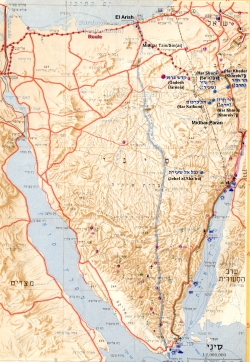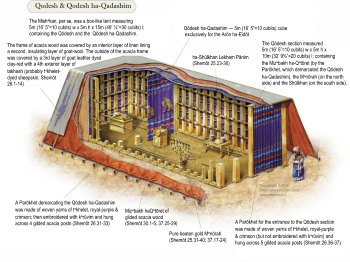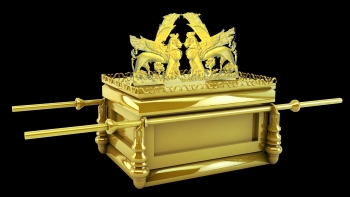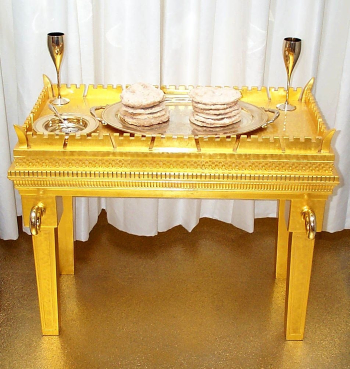
 |

 |
Then Mōsh•ëhꞋ perceived é‑‑ä speaking to him, saying,
“On 1stday
of 1stmonth,
you are to pitch the Mi•shᵊkânꞋ ŌꞋhël Mō•eidꞋ.
“Put the A•rōnꞋ hâ-Eid•ūtꞋ inside and screen the A•rōnꞋ with the Pâ•rōkhꞋët.
“Bring in the Shū•lᵊkh•ânꞋ and arrange the array [of lëkhꞋëm] on it.
“Bring in the Mᵊnōr•âhꞋ and prime its neir•ōtꞋ.
“Provide for the A•rōnꞋ ha-ZâꞋhav for qᵊtōrꞋët in front of the A•rōnꞋ hâ-Eid•ūtꞋ and hang the Pâ•rōkhꞋët-screen over the entrance of the Mi•shᵊkânꞋ.
“Next, provide for the Mi•zᵊbakhꞋ ha-Ōl•âhꞋ in front of the pëtꞋakh Mi•shᵊkânꞋ ŌꞋhël Mō•eidꞋ.
“Provide for the Ki•yōrꞋ between the ŌꞋhël Mō•eidꞋ and the Mi•shᵊkânꞋ, and provide for water in it.
“Next, put up the khâ•tzeirꞋ around it and hang the Pâ•rōkhꞋët-screen over the shaꞋar of the khâ•tzeirꞋ.”
 |
“Then you shall take the ShëꞋmën ha-Mi•shᵊkh•âhꞋ and mâ•shakhꞋ
the Mi•shᵊkânꞋ and everything within. Thusly shall you make it qōꞋdësh, including all of the utensils, and it shall be qōꞋdësh.
“Then you shall mâ•shakhꞋ
the Mi•zᵊbakhꞋ hâ-Ōl•âhꞋ and all of its utensils. Thusly shall you qâ•dashꞋ
the mi•zᵊbeiꞋakh. Then the mi•zᵊbeiꞋakh shall be QōꞋdësh ha-Qâ•dâsh•imꞋ.
“Next, you shall mâ•shakhꞋ
the Ki•yōrꞋ and its stand. Thusly shall you qâ•dashꞋ
it. Then, summon A•ha•rōnꞋ and his bân•imꞋ to the pëtꞋakh ŌꞋhël Mō•eidꞋ and cause them to bathe their hands and feet in the maꞋyim.
“Then you shall outfit A•ha•rōnꞋ in the qōꞋdësh clothes, mâ•shakhꞋ
him and qâ•dashꞋ
him so that he may officiate as Kō•heinꞋ for Me.
“Next, summon his bân•imꞋ and outfit them in kūtânꞋōt, mâ•shakhꞋ
them like you did their âv. Then they may officiate as kō•han•imꞋ for Me. Thus, there shall be a mi•shᵊkh•âhꞋ for their Kᵊhun•âhꞋ of the ō•lâmꞋ for their generations.”
“So Mōsh•ëhꞋ did; like everything that é‑‑ä tzi•wâhꞋ him. So he did.
 |
So it was, that on the 1st day![]() of 1stmonth
of 1stmonth![]() of 2ndyear,
of 2ndyear,![]() the Mi•shᵊkânꞋ was raised. Mōsh•ëhꞋ pitched the Mi•shᵊkânꞋ; providing the foundation-sockets, setting the planks, providing the bolt-bars, and raising its pillars. Then he pitched the ŌꞋhël above the Mi•shᵊkânꞋ and secured the tent-top over the ŌꞋhël Mō•eidꞋ within the Mi•shᵊkânꞋ compound, according as é‑‑ä tzi•wâhꞋ Mōsh•ëhꞋ.
the Mi•shᵊkânꞋ was raised. Mōsh•ëhꞋ pitched the Mi•shᵊkânꞋ; providing the foundation-sockets, setting the planks, providing the bolt-bars, and raising its pillars. Then he pitched the ŌꞋhël above the Mi•shᵊkânꞋ and secured the tent-top over the ŌꞋhël Mō•eidꞋ within the Mi•shᵊkânꞋ compound, according as é‑‑ä tzi•wâhꞋ Mōsh•ëhꞋ.
 |
Then he took hâ-Eid•ūtꞋ,![]() committed it into hâ-•rōnꞋ, placed the carrying-poles upon hâ-•rōnꞋ and committed ha-Ka•pōrꞋët onto hâ-•rōnꞋ.
committed it into hâ-•rōnꞋ, placed the carrying-poles upon hâ-•rōnꞋ and committed ha-Ka•pōrꞋët onto hâ-•rōnꞋ.
Then, he brought hâ-•rōnꞋ to ha-Mi•shᵊkânꞋ and hung the Pâ•rōkhꞋët-screen, which screened A•rōnꞋ hâ-Eid•ūtꞋ; according as é‑‑ä tzi•wâhꞋ Mōsh•ëhꞋ.
 |
 250x188.jpg) |
Then he provided ha-Shū•lᵊkh•ânꞋ in ŌꞋhël Mō•eidꞋ, midway-along![]() the north side of ha-Mi•shᵊkânꞋ, outside of the Pâ•rōkhꞋët.
the north side of ha-Mi•shᵊkânꞋ, outside of the Pâ•rōkhꞋët.
And he arrayed upon it an array of lëkhꞋëm before é‑‑ä; according as é‑‑ä tzi•wâhꞋ Mōsh•ëhꞋ.

Optional parental preparation:
Discussion point: Why are anthropomorphic (i.e. idolatrous) food sacrifices (i.e. lëkhꞋëm and bâ•sârꞋ) displayed for an anthropomorphic (i.e. idolatrous) god to consume its “essence” and then eaten by its priests, mimicking idolatrous temples, promulgated in the Mi•shᵊkânꞋ for a non-physical é‑‑ä? Centralizing what had, until then, been conducted by the head of the house in every household, enabled centralized control. Further, making sacrifice dependent upon both, a central temple and a genealogically-documented Kᵊhun•âhꞋ, ensured that the eventual loss of either would finally terminate both the Kᵊhun•âhꞋ and the entire sacrificial system—inexorably leading to the Beit Tᵊphil•âhꞋ prophesied by Yᵊsha•yâhꞋu (56.7). ![]()
Generations of the genealogical kō•han•imꞋ: male descendants of A•ha•rōnꞋ documented in the public yō•khas•inꞋ—which ceased to exist by the 2nd century C.E. with the Roman destruction of every Judaic genealogy (except for the paternal and maternal genealogies of RibꞋi Yᵊhō•shūꞋa, documentation which the Nᵊtzâr•imꞋ preserved in The Nᵊtzârim Reconstruction of Hebrew Matitᵊyâhu![]() ).
). ![]()
When is the 1st day of 1st month (on the Judaic-lunar calendar) this year?
Questions you might anticipate that your child might raise and be prepared to discuss:
What does “pitch a tent” mean?
What does “perceive” mean?
What is an “array”?
Before the invention of paint, how would the application of olive-oil have helped to protect wood, metal (i.e. copper) and skin?
What does it mean to dedicate or sanctify something, to be holy?
What does “officiate” mean?
What is a generation?
What does midway mean?
![]()
 |
 |